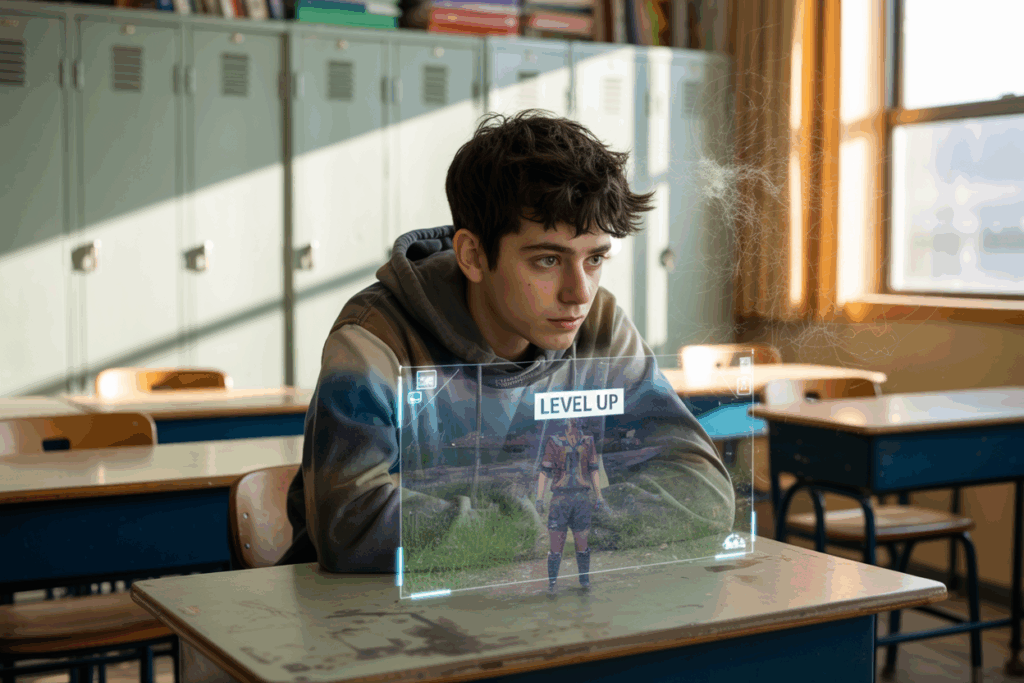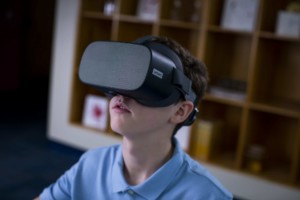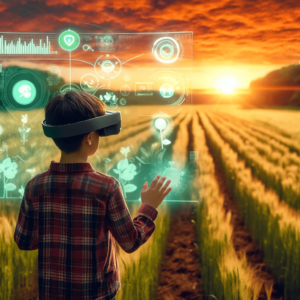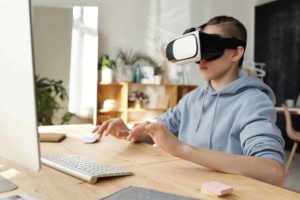Teaching in the Metaverse Generation: Aligning School with Virtual Life
Key Points
-
Educators must adapt classrooms to align with the fused digital and physical world that is second nature to Gen Z, including AI-aware policies and immersive learning activities.
-
Understanding norms in virtual spaces, such as digital ownership and ethical behavior, is critical for designing effective, engaging, and balanced learning experiences.

I spend nearly six hours each day consuming and creating social media content, including posts like this one. Each afternoon, I devote at least an hour to an augmented reality game that blends the virtual and physical worlds during my daily power walk. If you checked my bank statements, you’d see weekly expenditures of $10-$20 on digital items that outfit and enhance my avatars..
Although I willingly inhabit both physical and virtual realities, I’ve never been able to articulate what this means for me or for the people I engage with in each space. I often worry that this bridged reality has changed the very nature of my worldview and transferred behaviors from one realm to the other.
Now consider the challenge for educators guiding a generation that includes millions who instinctively navigate a world where the digital and physical are indistinguishable. The bridge I carefully tred is unnecessary for these learners; they simply live in a single, fused world.
Before we proceed I need to provide clarity about my use of the terms “digital” and “virtual,” which I use interchangeably even though there is a distinction: “Digital reality refers to the broad spectrum of computer-mediated environments, including all digital representations and interactions, while virtual reality specifically describes immersive, computer-generated simulations that replace the user’s real-world environment with a fully artificial one.”
My first insight comes from a New York Times interview where columnist Ezra Klein speaks with economist Kyla Scanlon, who publishes a Substack called Kyla’s Newsletter. In the Times article, Scanlon describes the lived experience of Gen Z, who are best understood via a three-part typology derived from the work of Rachel Janfaza. She labels the group we are teaching now as “Gen Z 2.0” and describes them in the following way: “Gen Z 2.0 is the people who are in college and high school now. They’re the first part of that generation that is entirely digital. For them, digital seems to be an extension of reality.”
Learners in this group clearly are an evolved form of the “digital natives” first noted by Marc Prensky in a famous 2001 article. Prensky described digital natives as having grown up with the Web, computers, video games, and other digital devices. Prensky argued that they think and process information differently from people who didn’t grow up surrounded by such technology.
What Prensky presciently hinted at and Scanlon lucidly describes is the yawning chasm between teachers and their students, for whom the thin veil that divides physical from digital reality is in fact gone. I stand, one foot in each world, and need a bridge. They inhabit a fused world.
The work of these authors, combined with my own experiences, has raised a series of questions that I intend to explore in this blog.
I wonder if the wholesale migration to online learning and AI tutoring systems is widening the generational chasm between teacher and student. I wonder if the arrival of AI companions (explored in my recent blog) will hasten the process. I wonder how we can castigate students for valuing the digital world when we require them to spend so much of their waking hours online, interacting with digital beings? I wonder if the rules of the physical world (the bricks and mortar of school) apply in the digital world?
Lastly, I wonder how educators create AI-aware classroom policies that acknowledge the administrative requirements of large-scale education systems with the lived experience of students who simply do not comprehend what those systems want from them? Bilinguals code switch between languages. Can we teach our students to code-switch between physical and virtual realities until the rules of both align?
How Teens View the Virtual World
Recent surveys have provided adults with an understanding of how teens view the relationship between their physical and virtual worlds. Most are in accord with what Scanlon describes in her New York Times interview:
- Digital as an extension; not a replacement: Teens see digital spaces — social media, gaming, and VR/AR XR — as extensions of their real-world lives. They use these platforms for entertainment, learning, socializing, and coping with stress, but recognize that online experiences can influence their emotions, self-image, and relationships in the real world.
- Critical awareness of digital content: Teens are highly aware that digital reality can distort or manipulate truth. They express concern over misinformation, algorithm-driven echo chambers, and the spread of unrealistic standards or harmful content.
- Desire for Guidance and Balance: Rather than rejecting digital life, teens want adults to help them navigate it responsibly. They ask for guidance in critical thinking, not bans or heavy-handed restrictions. Teens value moderation and understand the need for boundaries between digital and offline activities.
- Immersive Tech and Blurred Boundaries: With the rise of extended reality and virtual reality, teens are increasingly enthusiastic about immersive experiences, both for fun and practical uses like education. Many see these technologies as valuable tools, but also recognize the importance of privacy, moderation, and maintaining a healthy balance between digital and physical worlds.
- Digital Reality as Social and Emotional Space: Platforms like TikTok, YouTube, and gaming communities such as Discord are not just sources of entertainment – they are social arenas where teens build friendships, express themselves, and sometimes seek escape from real-world pressures.
The virtual world has been invaded by the paraphernalia of learning, embodied in Learning Management Systems, Student Information Systems, online classes, AI tutors, simulations, etc. Educators and computer engineers spend time and resources developing these resources, but to be effective, they must align with how teenagers function in virtual spaces and the norms they use to navigate them.
Norms of the Virtual World
If you are or were a gamer, you may be aware that the norms of virtual behavior can vary significantly from those that delineate our actions in school or physical learning spaces. I could riff at length on this topic, but I’ll abbreviate my observations to point out the most pertinent:
- Anonymity can embolden students to behave in ways they wouldn’t in person, including cyberbullying, trolling, or using inappropriate language. Social norms may be less clear or enforceable.
- Online environments, especially games and social media, often have flexible timing. There may be little consequence for being late or missing an online event, unless part of a team-based activity.
- Digital property (e.g., avatars, digital currency, creative content) can be copied, shared, or stolen easily. Students may not fully grasp the concept of digital ownership or the consequences of violating it.
- Avatars, usernames, and digital personas can blur lines of propriety. Students may encounter or engage in behavior that would be unacceptable at school (e.g., inappropriate avatars, oversharing personal information).
- Games and social platforms may present moral dilemmas with no clear right or wrong answer. Some environments allow or even encourage “rule-bending,” leading to ethical relativism.
- Social media amplifies peer influence, sometimes encouraging risky or unethical behavior for likes or attention.
- Consequences for unethical behavior may be less immediate or obvious, and students might not see the impact of their actions on others..
Reconciling the Norms To Enhance Learning
Let’s examine a few teaching activities that align with the list of virtual-world norms I described above. Take this link to see extended descriptions of these activities as well as a prompt template that will allow you to turn each of them into a timed lesson plan customized for your grade level and context.
1. Anonymity, Trolling, and Cyberbullying: “Digital Shadows” Role-Play & Reflection: Divide students into small groups. Provide each group with an anonymous online comment scenario (e.g., trolling on a class discussion board, posting hurtful memes, or flaming in a gaming chat). Have each group role-play.
2. Flexible Timing and Accountability: Time Lords” Gaming-Inspired Team Challenge: Run a week-long team project with daily check-ins. Assign each team a task with individual deadlines (daily micro-tasks) as well as team-dependent deadlines (each member’s completion unlocks next task)
3. Digital Property and Ownership: Steal My Skin? Digital Ethics Debate: Showcase a popular digital good (e.g. Fortnite skins, Roblox builds, or AI art). After a discussion, assign students to groups to create short digital PSAs (posters or reels) on “Respecting Digital Property in School and Beyond.”
4. Avatars, Personas, and Propriety: Avatar Audit & School Persona Code Switch: Ask students to anonymously submit or describe an avatar or username they use online. Display a few (without names) and discuss. Have students design a “school-safe avatar or username” for class platforms, explaining their choices in writing.
5. Moral Dilemmas and Rule-Bending: Choose Your Own Ethics” Interactive Scenarios: Develop or use existing moral dilemma scenarios common in games (e.g. cheat codes, glitch exploitation, buying followers). Students choose actions in small groups, then debate related questions. Extend with a reflection essay: “Would I Do This If There Were Real Consequences?”
6. Invisible Consequences of Unethical Behavior: Ripple Effect Simulation: Create an activity where students write a private online insult about a fictional classmate on a sticky note. Read them aloud (anonymously) while students stand in a circle. Each negative comment leads to one student stepping back. Follow with group discussion.
You need not rely simply on these suggestions, most of which were plucked from a variety of instructional sources. Identify real-world virtual-world disconnections that plague your school and prompt any Large Language Model (ChatGPT, Claude, Copilot, Grok, Gemini, etc.) for lesson ideas.
When Worlds No Longer Collide
I am eternally grateful that I have been involved in educational technology for 50 years, beginning with my attempts in the 1970s to program software that students in the French Department of my university could use to learn grammar. I have taught and learned through the classroom arrival of calculators, computers, laptops, printers, CD-ROMs, the Web, wi-fi, Smartboards, Learning Management Systems, gamification, social media, and now generative AI.
The fusion of the virtual and the physical, supercharged by the arrival of AI, is unlike anything I have seen before. I was first a digital immigrant and now a virtual immigrant. I’ve become nearly fluent, yet I still feel like an outsider in this world. I suspect that many of my fellow educators feel the same.
I wonder if the musings you have read here and the classroom activities you may use to bridge the separation between worlds are at best a temporary fix. Ray Kurzweil predicted that the Singularity (a merging of human and machine intelligence, where humans transcend the limitations of their biological bodies and brains) would arrive sometime around 2045. In my view, the fusion of virtual and physical into a seamless reality — where the distinction between the two disappears — will arrive in our classrooms within just a few years.








0 Comments
Leave a Comment
Your email address will not be published. All fields are required.